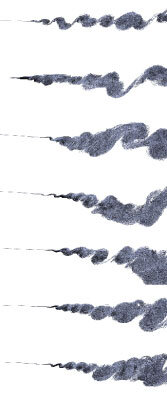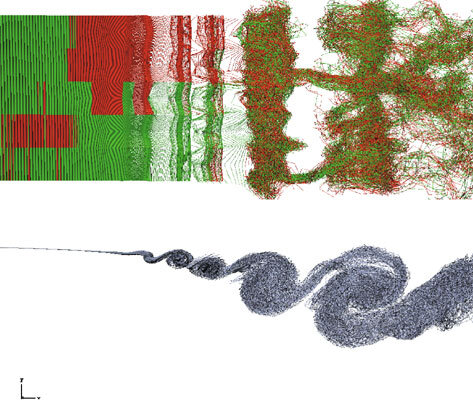
National Science Foundation (NSF) - SBIR Phase I Contract
Our objective was to create a state-of-the-art CFD capability built upon the Vorcat technology for applications involving two-phase, particulate, incompressible turbulent flow fields.
In this initial Phase I, the work focused on achieving two goals: (i) To analyze, develop, and implement the necessary modifications to the vortex method to include the coupled two-phase, fluid-particulate simulation capability and, (ii) To perform limited testing and validation studies as time permits. In particular, to compare a passive scalar model (with or without external forces) with a two-way coupling model for simple settings.
The Vorcat code was applied to the computation of the spatially growing three-dimensional planar mixing layer. A number of full-scale, long time calculations were made that established the accuracy and effectiveness of the approach. The statistics and structural aspects of the mixing layer agreed with experiments. The Vorcat simulations went beyond previous analyses to reveal heretofore-unobserved aspects of the mixing layer vortices. Having established the physicality of the underlying mixing layer flow, calculations were then performed in which the flow was seeded with solid particles.
Initially the case of one-way coupling was studied for particles with Stokes numbers of 0.001, 1, 4 and 100, where the Stokes number is defined as the ratio of particle time scale to fluid time scale. The results agreed with previous measurements and numerical studies and provided information about particle dispersion in the 3D mixing process that is not present in studies of 2D mixing layers or streamwise periodic, temporal mixing layers. Finally a series of runs were made that included two-way coupling between the particulate and fluid phases. In these, the Vorcat code was modified to include the effect of embedded particles in generating new vorticity. With this extension several calculations were made with different particle loadings and the effect was noted of new vortices produced by two-way coupling on the mixing layer structure. In summary, the goals of the phase one project were successfully completed.






Results
Detailed results of this study were reported in our final technical report and portions of the results have been published as an AIAA conference paper listed above. Currently, an archival journal article is in preparation that will describe the computed structure of the 3D mixing layer and the results of the particle simulations.
Shown here are several images that clearly display the powerful new simulation capability of Vorcat. For example, Images 1-3 contain renderings of the vortex elements appearing in the calculations of the mixing layer. Image 1 shows a side view of the vortex elements at a series of increasing times, while in Images 2 and 3 the side views at times t = 3.65 and 10.45 are matched with plan views. The green and red in the plan views refer to plus and minus streamwise circulation, respectively, and is determined (somewhat imprecisely) according to whether or not the end of a particular filament is upstream of downstream of its beginning. Examination of the plan views over time does indicate that the rib vortices in the braid region between rollers usually consist of counter-rotating streamwise vortex pairs. This is particularly evident in Image 3 where two significant rib vortices are visible in the braid region that are made up of green and red vortices lying side by side. It is also evident from Images 2 and 3 that some caution is needed in judging the side views in Image 1 since there is generally more coherency to the vortical motions than may be evident in a sideways-integrated view.
Image 4 shows particle dispersion for three different Stokes numbers, 0.001, 4, and 100. The image shows particle positions after being seeded into the flow at the inlet plane. Here blue is used to mark particles beginning in the bottom layer and red the particles in the top layer. The particles show a sensitivity to Stokes number (St), with maximum dispersion in the range near St = 4 due to centrifugal forces flinging particles to the outer edge of vortices. For small St the particles behave like fluid particles and tend to fill out the vortex cores, while at high Stokes number the particles are able to show resistance to the rollers and end up displacing a much-reduced amount.
Finally, Images 5 and 6 show vortons and particles in the x-y plane at the same time for Stokes number 4 for both one and two-way coupling, respectively. The particles (represented by gray spheres) are clearly seen to be flung to the outside of the major rollers. In Image 6 it is evident that the particles have created vorticity on the outer edges of the rollers (depicted in pink).
RE: Peter Bernard, Mark Potss, and Jacob Krispin, Studies of Turbulent mixing using the Vorcat Implementation of the 3D Vortex Method, AIAA 2003-3599, 33rd AIAA Fluid Dynamics Conference, Orlando, FL, 23-26 June, 2003.
